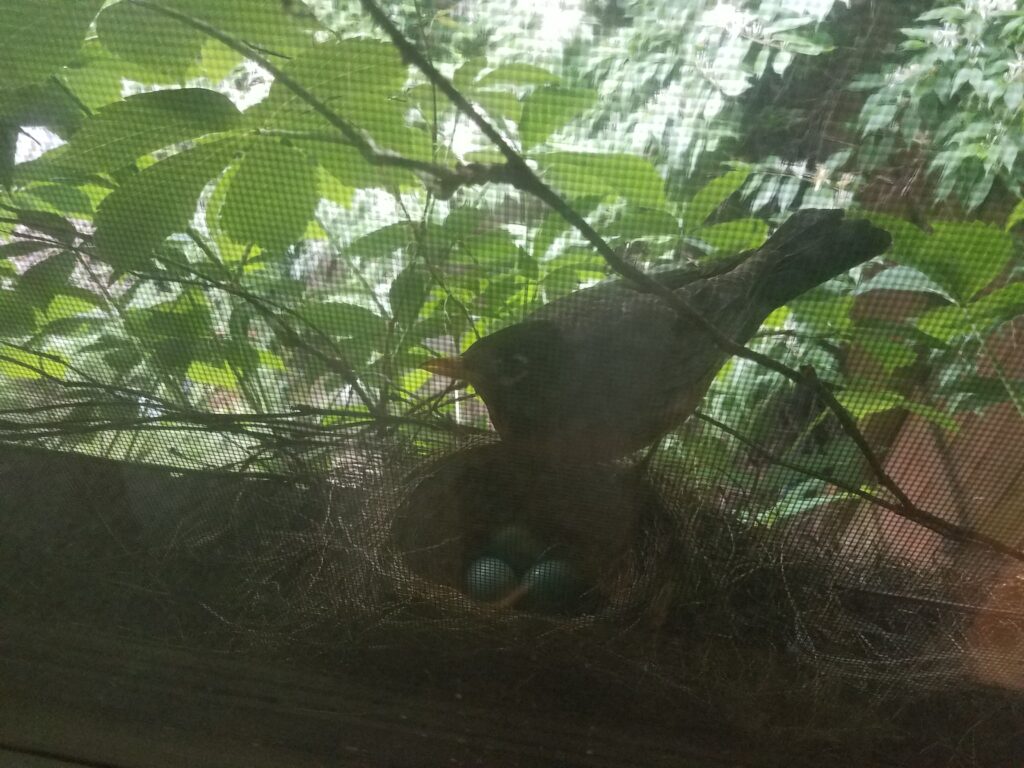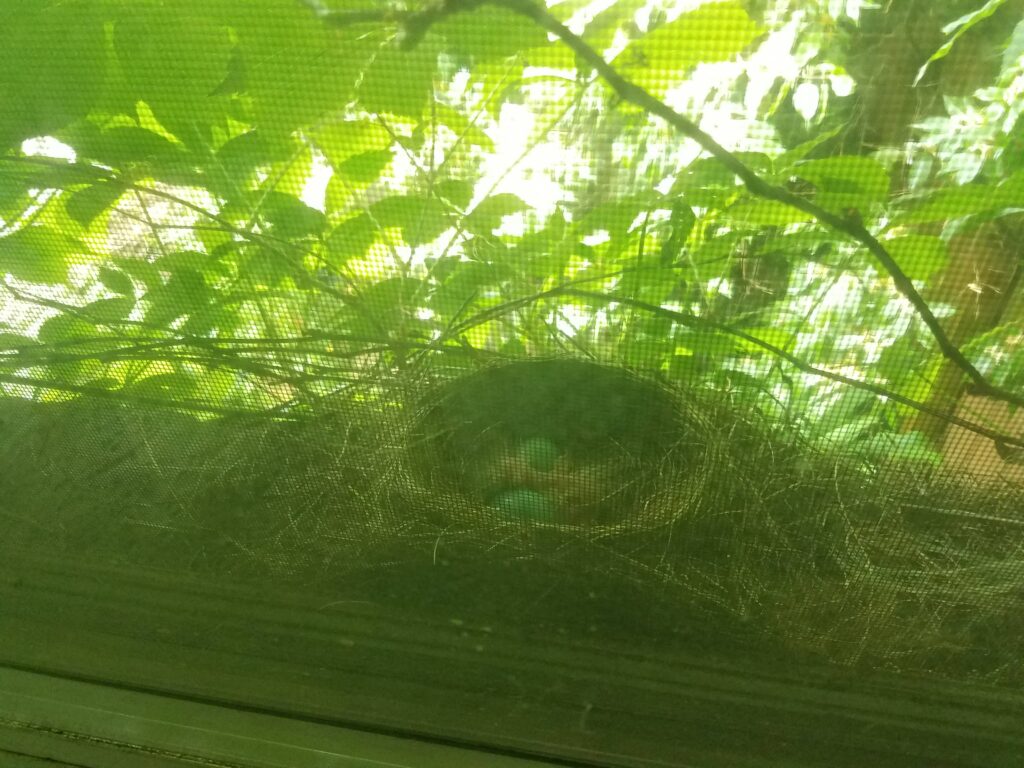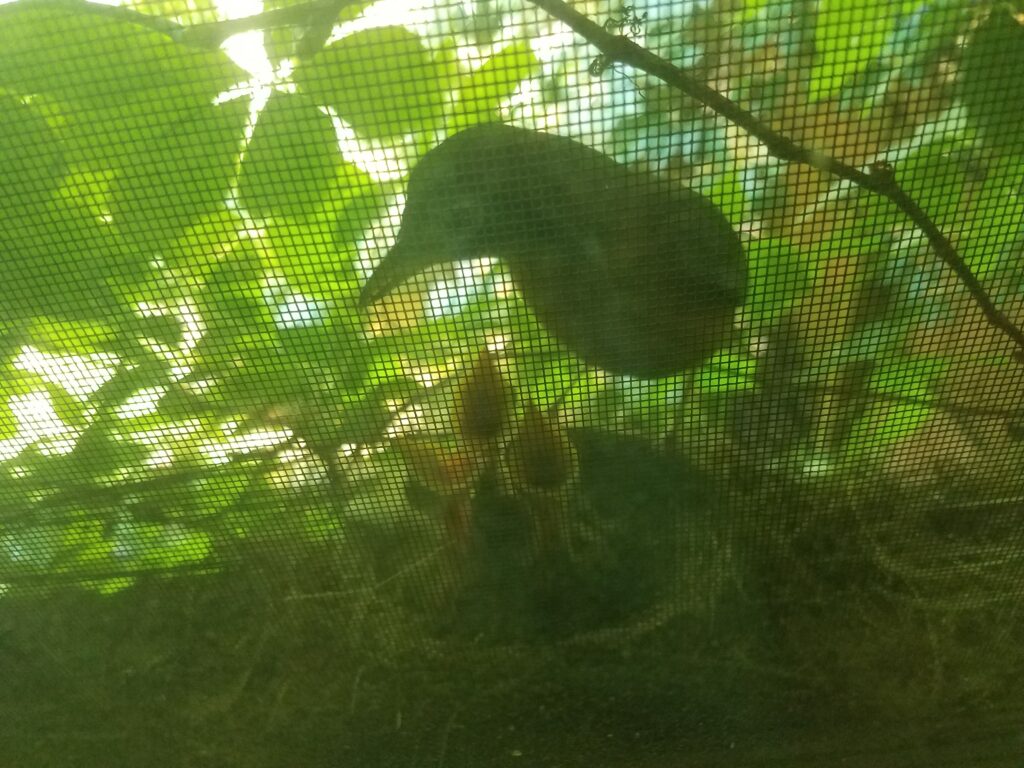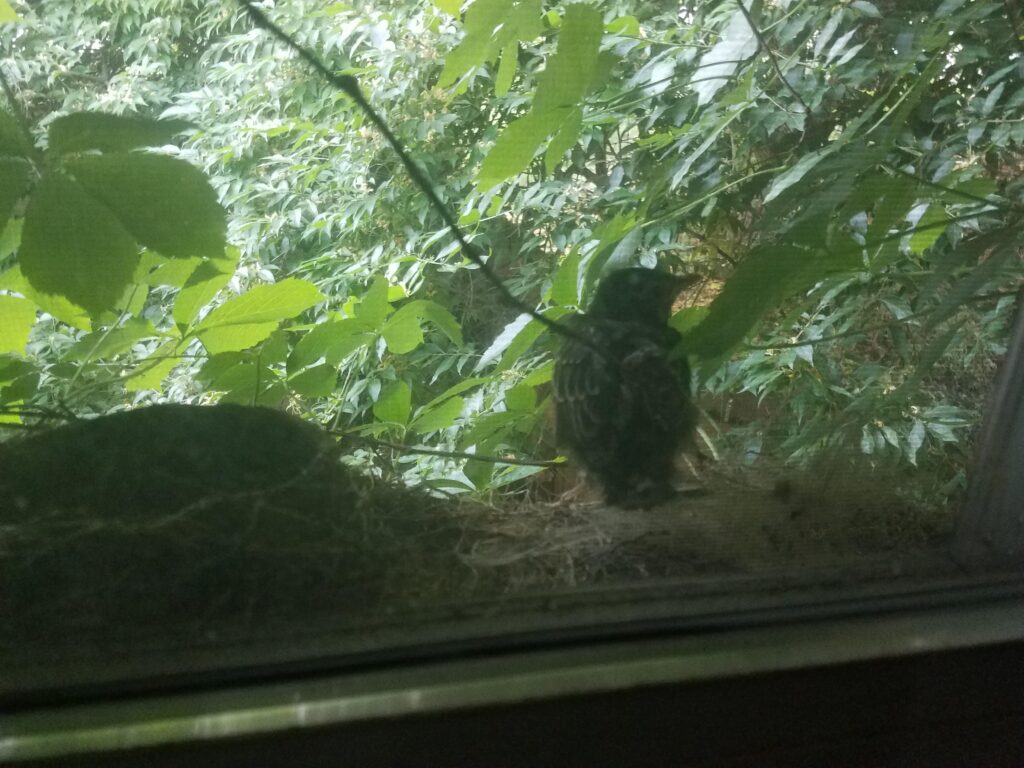One of the things I love most about spending time in my garden, especially as it becomes more of a native plant paradise, is seeing more animals interact with it. Certainly, the whole point of starting a pollinator garden in the first place was to support native bees, but plenty of other insects make use of it as well… and when you have more insects frequenting your yard to make a buffet of your plants, you will most certainly have more birds, making a buffet of your insects… and so on. And this spring I’ve had not only the respective joy and frustration of watching new green lacewings and aphids come into the world,[1] but I’ve also had the chance to get a closer look at some animal child-rearing as well.
Early Bird
My mom and I always have a competition each year to see who can spot the first robin of spring. And although her weather back east is usually a few weeks ahead of mine, it does appear that Pittsburgh is closer to the robin’s year-round range, while Philly is firmly in the robin’s breeding range (where they travel when the weather gets warmer).[2] And when I think about it, I do recall that I’ve usually seen them first, even if it does take a little longer for my flowers to start blooming.

When I’m out and about in the garden, I usually get at least one robin friend following me around as I pull up weeds. Since robins eat mostly berries and invertebrates, the churn of garden soil is enticing. And whenever I come across a grub, I will toss it out into the driveway, where it is usually consumed pretty quickly. Notably, early spring is an important time for robins because that’s when they start working on the next generation, and they are one of the earliest birds to lay their eggs each spring, which is exactly what I got to watch this year.
There was a robin’s nest outside our bedroom window last year, and we did occasionally hear bird noises, but we rarely managed to get a good view of it until it was empty. I had no idea if robins used their same nests from year to year (they don’t), so I left it in place at the end of the season and through the winter in case it would be helpful. Then one day early this spring, I noticed it had been relocated to the ground below the window. Around that same time, we couldn’t help but notice a male robin regularly attacking that window, as males tend to do when they see a threat – or their own reflection.[3] Not long after that, we saw a new nest.

Nest Egg
I tried to get a better look at the nest and its inhabitants this year while everything was in process, but it is very important to remember that robins may abandon their nests if they think they’ve been discovered, so I would have been very happy to forego a view of baby robins in order to ensure their safety. However, I did manage to get a number of pictures, usually by moving my phone in between the window and curtains – so as not to have my face hovering over the poor mama and babies.
I did not know how involved robin dads are in the fatherhood process, and I was pleasantly surprised to learn that they are actually very helpful and responsible. They help build the nest (which probably explains the constant banging during construction), stay nearby to protect the mama and the nest while she’s incubating the eggs, and then once the babies are hatched, the dad helps feed them (a full-time job in conjunction with the mom) and teaches them to fly.[4]

Robin mothers usually lay about four eggs. Ours laid three (that we know of), and all hatched. The survival rate from egg, to chick, to fledgling is already low (an average of two successful fledges per nest, where the average is four eggs),[5] and only about 25% of fledglings live to see November.[6] Nature is brutal, and this story isn’t going to be entirely pleasant. A week or so after all three hatched, there were only two babies in the nest, so I went outside to check if one had fallen out. I knew how silly the words “I hope it’s OK” sounded as they were coming out of my mouth. As I was putting my shoes on, Christian asked if we were about to get a pet robin. I told him no, but I still did want to see if I could help.
Circle of Life
I didn’t find anything on the ground near the window, and it’s possible that any number of things could have happened. It may have died in the nest, at which point one of the parents likely would have removed it; it may have fallen out of the nest, at which point it could have been eaten by a predator. If I did find it, and it was still alive, I probably would have tried to get it back into the nest. It is possible to put baby robins back in their nest, as their parents recognize them by sight and sound, not smell. It is important, however, not to move the nest or disturb it in any way, as the parents might abandon it (and the other babies), fearing predators. DO NOT try to raise a baby robin on your own – only certified wildlife rehabilitators can legally do that, and even they are rarely successful.[7] Unfortunately, more often than not, the correct approach is not getting involved.

I wasn’t sure how long it would take for the two remaining babies to leave, but they were getting big, and the nest seemed cramped. At the beginning of June, one looked distinctly larger than the other, and I wondered if that one would leave first, which sometimes happens. Christian and I had gotten very used to the trilling chirps of the babies every morning, but the first Saturday of June I woke up before dawn to some distinctly adult vocalizations. Once I looked out the window, there was one baby left, standing on the windowsill – I could only assume that the father had just been there to encourage it out of the nest.
The baby spent most of the morning waddling around (not unlike R2D2) on the sill and flapping its wings, but by midday it was gone. The father takes fledglings to roost nearby as they are getting used to flying and feeding themselves. Meanwhile, if it’s earlier in the season, the mom is off in her new nest, working on the next clutch of eggs. Robins typically have two broods in a season, but they can do three if they’re feeling particularly industrious and if conditions are favorable. Since robins don’t reuse their nests, you can remove the nest once it’s no longer being used and create space for the next family.[8]
~
I’m looking forward to seeing some fluffy, speckled juvenile robins in my yard in the weeks to come, and I’ve got plenty more weeding to do, which I’m sure the dislodged grubs will be a pleasant surprise for hungry, growing babies and their hardworking parents.
Do you have any robin stories from your yard? I’d love to hear them in the comments.
Thanks for reading, and happy birdwatching!
Update: Hours after this post went live, I found the body of our little fledgling, strangled in some kind of plastic line that looked like it had been incorporated into the nest. The dad was still nearby, clearly agitated when anyone came close to his baby. It was absolutely heartbreaking and such a potent reminder of the life-and-death impacts our actions (including what we buy and how we dispose of our garbage) have on the world around us.
Keep Reading About Baby Animals –>
[1] https://radicalmoderate.online/insect-warfare-aphids/
[2] https://en.wikipedia.org/wiki/American_robin
[3] http://birding-world.com/robin-attacking-windows/
[4] https://journeynorth.org/tm/robin/Mates
[5] https://journeynorth.org/tm/robin/ExpertAnswer13.html
[6] https://www.allaboutbirds.org/guide/American_Robin/overview#
[7] https://www.allaboutbirds.org/news/can-i-raise-a-baby-bird-i-found/
[8] https://journeynorth.org/tm/robin/facts_general_help.html
0 Comments